Design of Tendon-Driven Mechanism Using Geometrical Condition
Abstract
:1. Introduction
2. Robot Model
2.1. Framework and Tendon-Driven Mechanism
2.2. Mathematical Model
2.3. Geometrical Condition for Desired Force Direction and Magnitude on the Endpoint
- Set angles (i = 1, 2, 3) that satisfy the condition of the behavior.
- Calculate the constant value, K = −F/T, by determining F and T.
- Set circle Ci (i = 1, 2, 3), whose radius is Ri and center is joint Ji (see Figure 3).
- Set line t1 that is tangent to circle C1 and passes through P0. t1 is the set of candidates of pulley positions P1.
- Set line t3 that is tangent to circle C3 and passes through P3. t3 is the set of candidates of pulley positions P2.
- Pulley position P1 is determined on line t1, or position P2 is determined on line t3.
- 6-1.
- When P1 is determined, line t2 that is tangent to circle C2 and passes through P1 is set, and P2 is determined as the intersection point of t2 and t3.
- 6-2.
- When P2 is determined, line t2 that is tangent to circle C2 and passes through P2 is set, and P1 is determined as the intersection point of t1 and t2.
2.4. Configuration of Physical Robot
3. Realization of Vertical Jumping
3.1. Condition for Vertical Jumping
3.2. Numerical Solution of Pulley Position
3.3. Experiment (1): Measurement of Vertical Force
3.4. Experiment (2): Vertical Jumping
4. Generation of Force Toward Desired Direction
5. Conclusions
Funding
Acknowledgments
Conflicts of Interest
References
- Xu, Z.; Kumar, V.; Todorov, E. A low-cost and modular, 20-DOF anthropomorphic robotic hand: Design, actuation and modeling. In Proceedings of the 2013 13th IEEE-RAS International Conference on Humanoid Robots (Humanoids), Atlanta, GA, USA, 15–17 October 2013; pp. 368–375. [Google Scholar]
- Higashimori, M.; Kaneko, M.; Namiki, A.; Ishikawa, M. Design of the 100G capturing robot based on dynamic preshaping. Int. J. Robot. Res. 2005, 24, 743–753. [Google Scholar] [CrossRef]
- Songac, S.; Lib, Z.; Yua, H.; Ren, H. Shape reconstruction for wire-driven flexible robots based on Bézier curve and electromagnetic positioning. Mechatronics 2015, 29, 28–35. [Google Scholar] [CrossRef]
- Iii, R.J.W.; Jones, B.A. Design and Kinematic Modeling of Constant Curvature Continuum Robots: A Review. Int. J. Robot. Res. 2010, 29, 1661–1683. [Google Scholar]
- Liu, T.; Mu, Z.; Xu, W.; Yang, T.; You, K.; Fu, H.; Li, Y. Improved Mechanical Design and Simplified Motion Planning of Hybrid Active and Passive Cable-Driven Segmented Manipulator with Coupled Motion. In Proceedings of the 2019 IEEE/RSJ International Conference on Intelligent Robots and Systems (IROS), Macau, China, 4–8 November 2019; pp. 5978–5983. [Google Scholar]
- Wei, Z.; Song, G.; Zhang, Y.; Sun, H.; Qiao, G. Transleg: A wire-driven leg-wheel robot with a compliant spine. In Proceedings of the 2016 IEEE International Conference on Information and Automation (ICIA), Ningbo, China, 1–3 August 2016; pp. 7–12. [Google Scholar]
- Kitano, S.; Hirose, S.; Horigome, A.; Endo, G. TITAN-XIII: Sprawling-type quadruped robot with ability of fast and energy-efficient walking. Robomech J. 2016, 3, 1–16. [Google Scholar] [CrossRef]
- Spröwitz, A.; Ajallooeian, M.; Tuleu, A.; Ijspeert, A. Kinematic primitives for walking and trotting gaits of a quadruped robot with compliant legs. Front. Comput. Neurosci. 2014, 8, 1–13. [Google Scholar]
- Seok, S.; Wang, A.; Chuah, M.Y.; Otten, D.; Lang, J.; Kim, S. Design Principles for Highly Efficient Quadrupeds and Implementation on the MIT Cheetah Robot. In Proceedings of the 2013 IEEE International Conference on Robotics and Automation, Karlsruhe, Germany, 6–10 May 2013; pp. 3307–3312. [Google Scholar]
- Yamaguchi, T.; Ambe, Y.; Ando, H.; Konyo, M.; Tadakuma, K.; Maruyama, S.; Tadokoro, S. A Mechanical Approach to Suppress the Oscillation of a Long Continuum Robot Flying with Water Jets. In Proceedings of the 2019 IEEE/RSJ International Conference on Intelligent Robots and Systems (IROS), Macau, China, 4–8 November 2019. [Google Scholar]
- Li, Z.; Wu, L.; Ren, H.; Yu, H. Kinematic comparison of surgical tendon-driven manipulators and concentric tube manipulators. Mech. Mach. Theory 2017, 107, 148–165. [Google Scholar] [CrossRef]
- Viau, J.; Chouinard, P.; Bigue, J.-P.L.; Julio, G.; Michaud, F.; Shimoda, S.; Plante, J.-S. Projected PID Controller for Tendon-Driven Manipulators Actuated by Magneto-Rheological Clutches. In Proceedings of the IEEE/RSJ International Conference on Intelligent Robots and Systems, Hamburg, Germany, 28 September–2 October 2015; pp. 5954–5959. [Google Scholar]
- Chen, T.; Haas-Heger, M.; Ciocarlie, M.T. Underactuated Hand Design Using Mechanically Realizable Manifolds. In Proceedings of the 2018 IEEE International Conference on Robotics and Automation (ICRA), Brisbane, Australia, 21–25 May 2018; pp. 7392–7398. [Google Scholar]
- Takuma, T.; Takai, K.; Iwakiri, Y.; Kase, W. Body design of tendon-driven jumping robot using single actuator and wire set. In Proceedings of the 21st International Conference on Climbing and Walking Robots and Support Technologies for Mobile Machines (CLAWAR 2018), Panama City, Panama, 9–12 September 2018; pp. 93–100. [Google Scholar]
- Rombokas, E.; Theodorou, E.; Malhotra, M.; Todorov, E.; Matsuoka, Y. Tendon-Driven Control of Biomechanical and Robotic Systems: A Path Integral Reinforcement Learning Approach. In Proceedings of the 2012 IEEE International Conference on Robotics and Automation, Saint Paul, MN, USA, 14–18 May 2012; pp. 208–214. [Google Scholar]
- Inouye, J.M.; Valero-Cuevas, F.J. Anthropomorphic tendon-driven robotic hands can exceed human grasping capabilities following optimization. Int. J. Robot. Res. 2014, 33, 694–705. [Google Scholar] [CrossRef]
- Nabawy, M.R.A.; Sivalingam, G.; Garwood, R.J.; Crowther, W.J.; Sellers, W.I. Energy and time optimal trajectories in exploratory jumps of the spider Phidippus regius. Sci. Rep. 2018, 8, 7142. [Google Scholar] [CrossRef] [PubMed]
- McGowan, C.P.; Baudinette, R.V.; Usherwood, J.R.; Biewene, A.A. The mechanics of jumping versus steady hopping in yellow-footed rock wallabies. J. Exp. Biol. 2005, 208, 2741–2751. [Google Scholar] [CrossRef] [PubMed] [Green Version]
- Burrows, M. Anatomy of the hind legs and actions of their muscles during jumping in leafhopper insects. J. Exp. Biol. 2007, 210, 3590–3600. [Google Scholar] [CrossRef] [PubMed] [Green Version]
- Hildebrand, M. The Mechanics of Horse Legs. Am. Sci. 1987, 75, 594–601. [Google Scholar]
- Lai, W.; Cao, L.; Tan, R.X.; Tan, Y.C.; Li, X.; Phan, P.T.; Tiong, A.M.H.; Tjin, S.C.; Phee, S.J. An Integrated Sensor-Model Approach for Haptic Feedback of Flexible Endoscopic Robots. Ann. Biomed. Eng. 2020, 48, 342–356. [Google Scholar] [CrossRef] [PubMed]
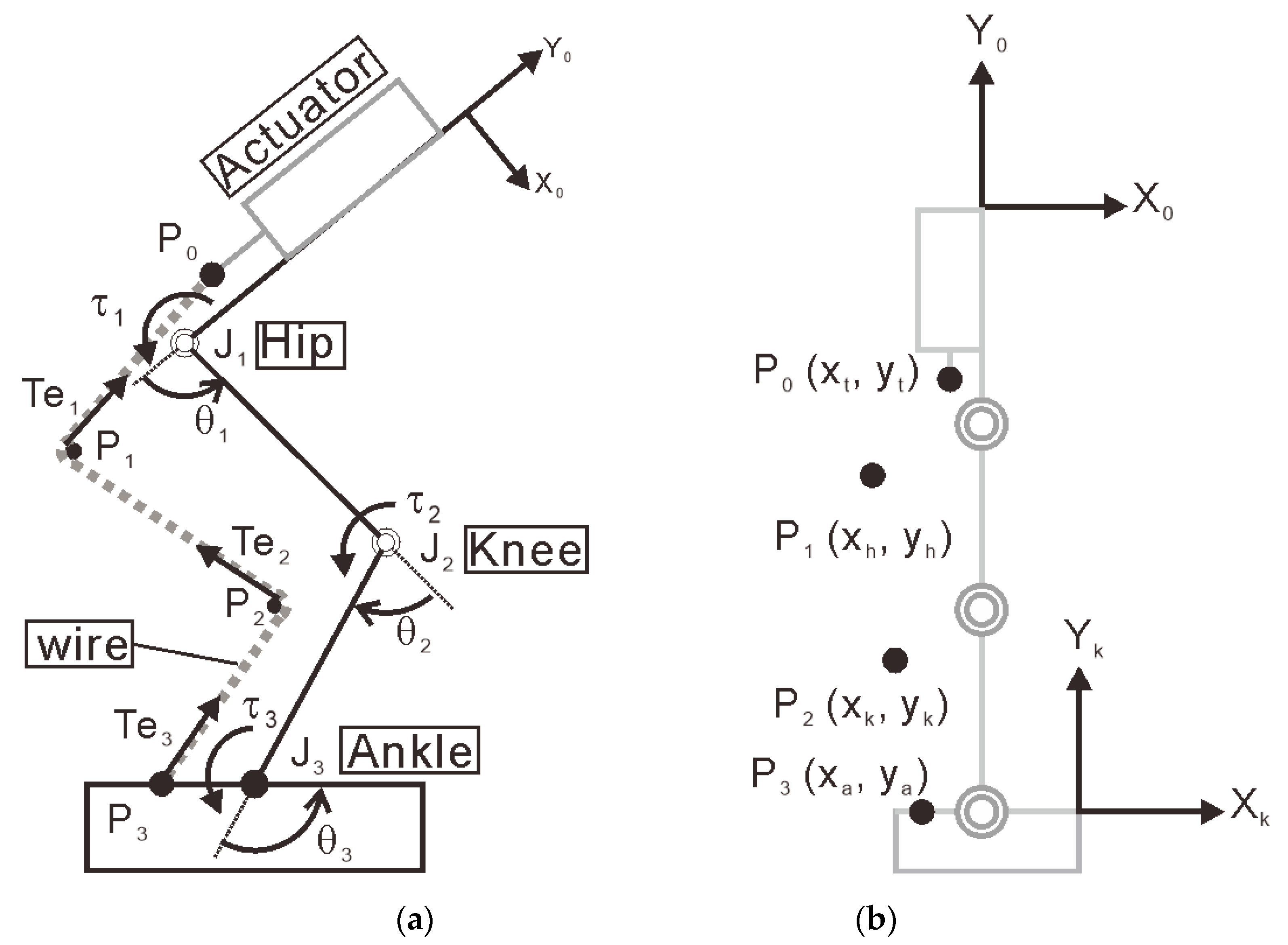
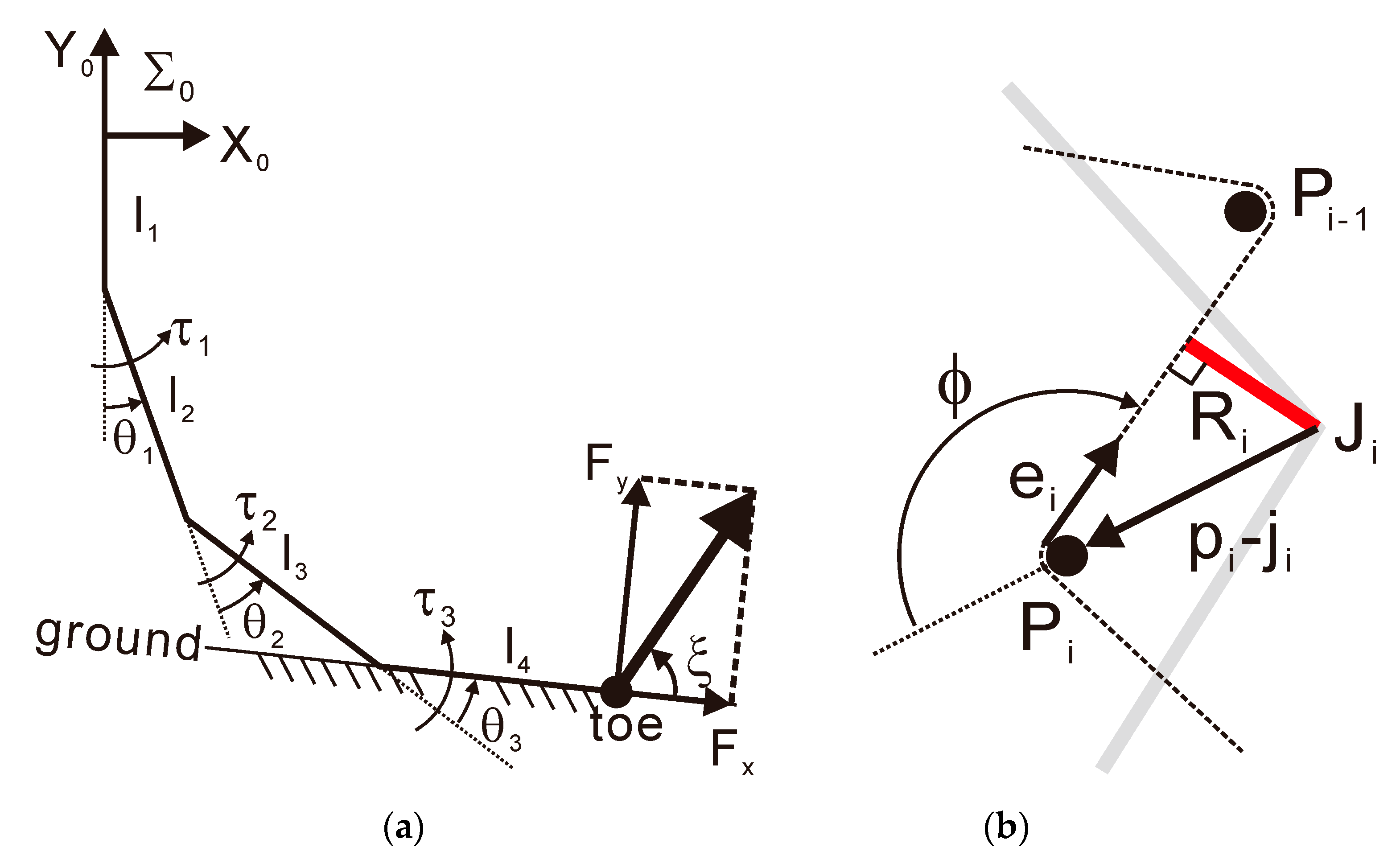
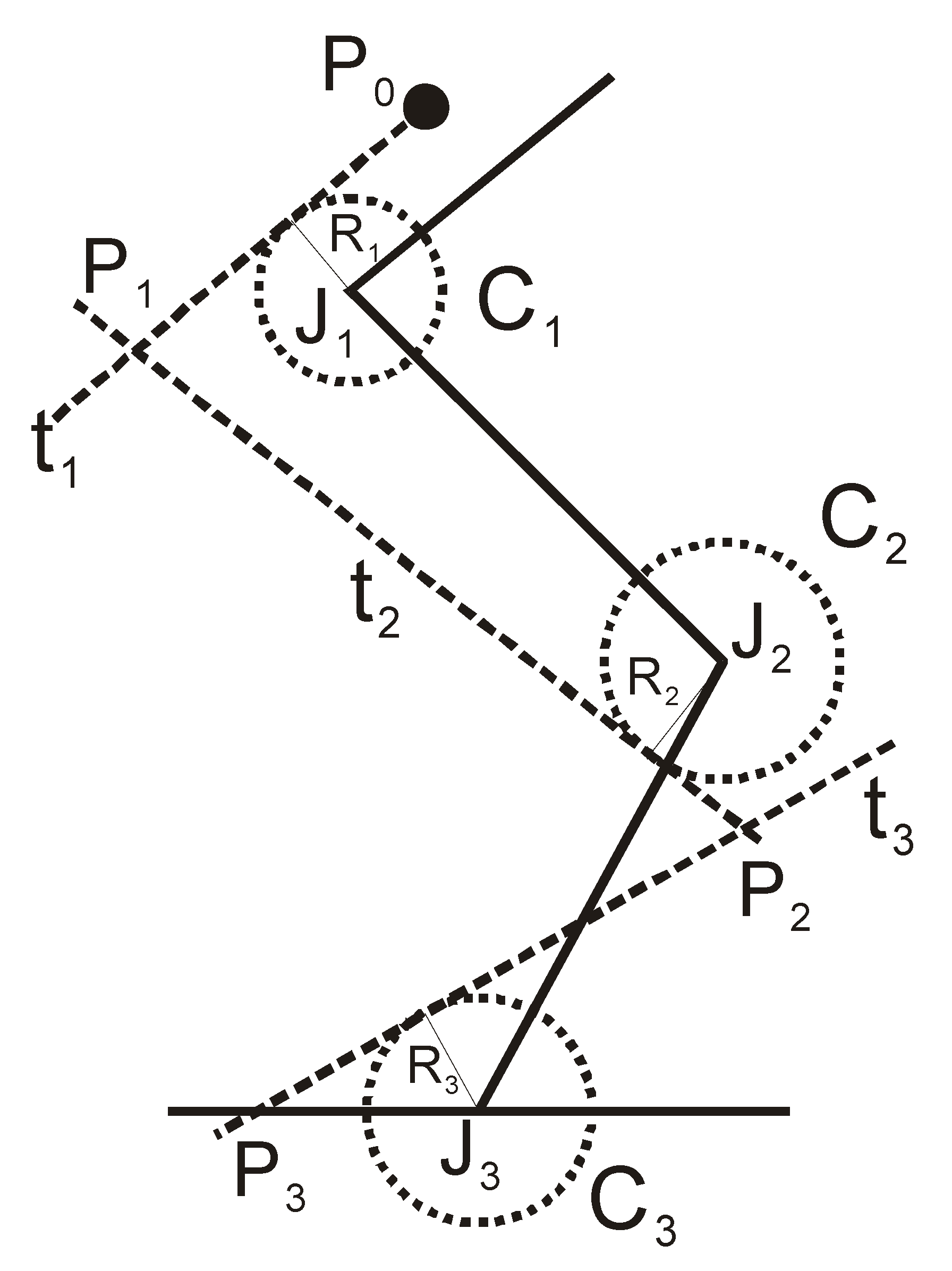
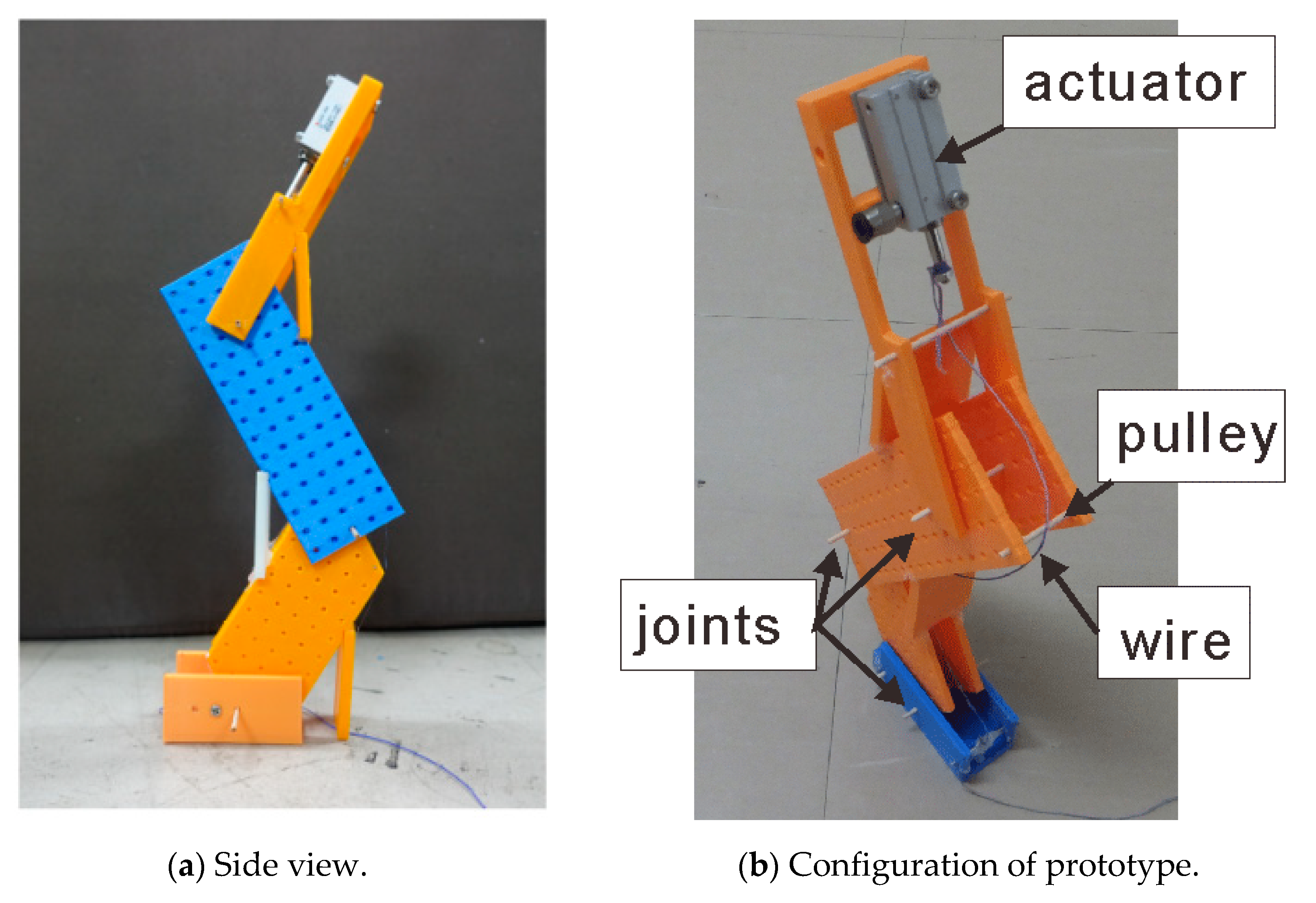
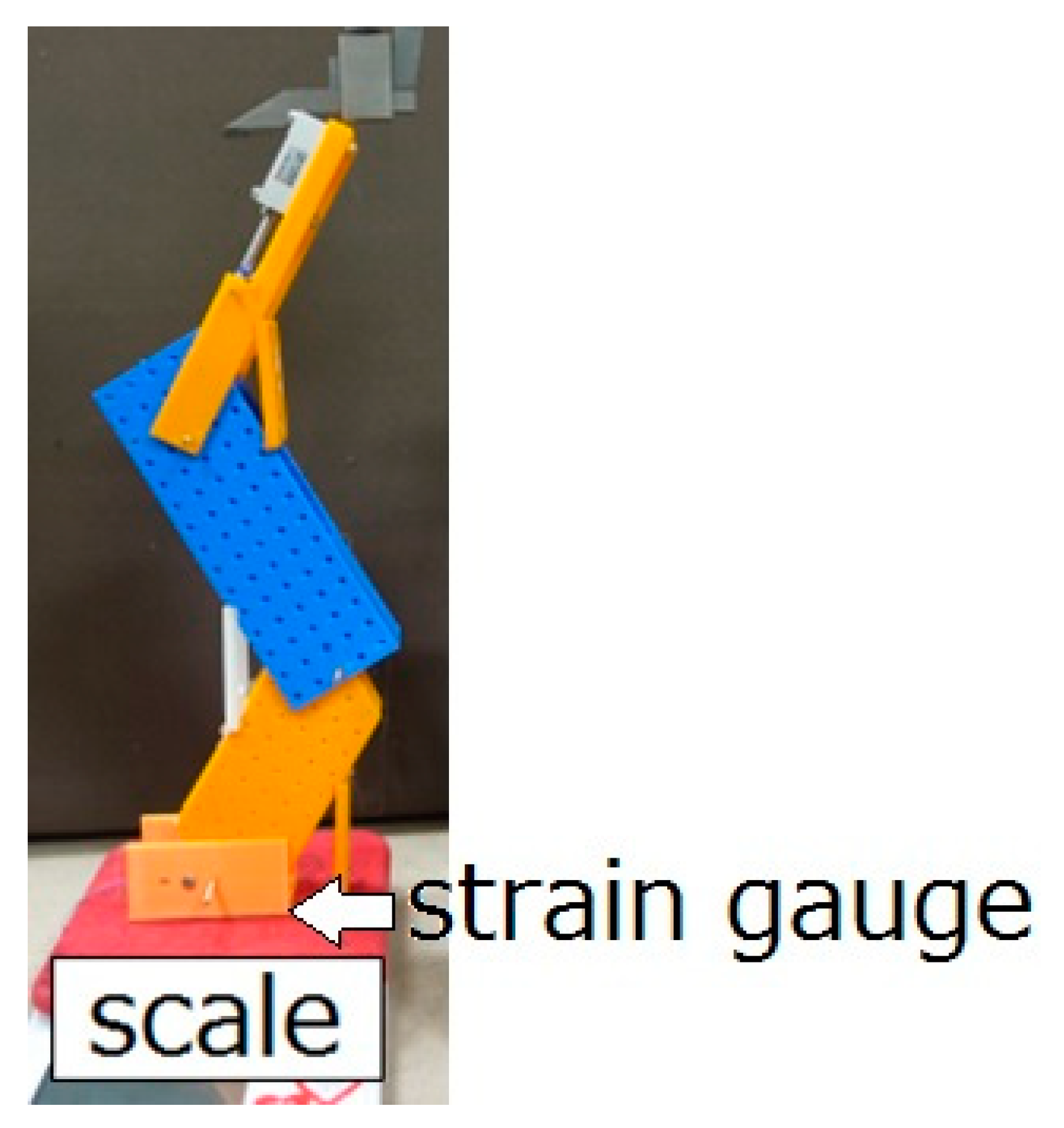
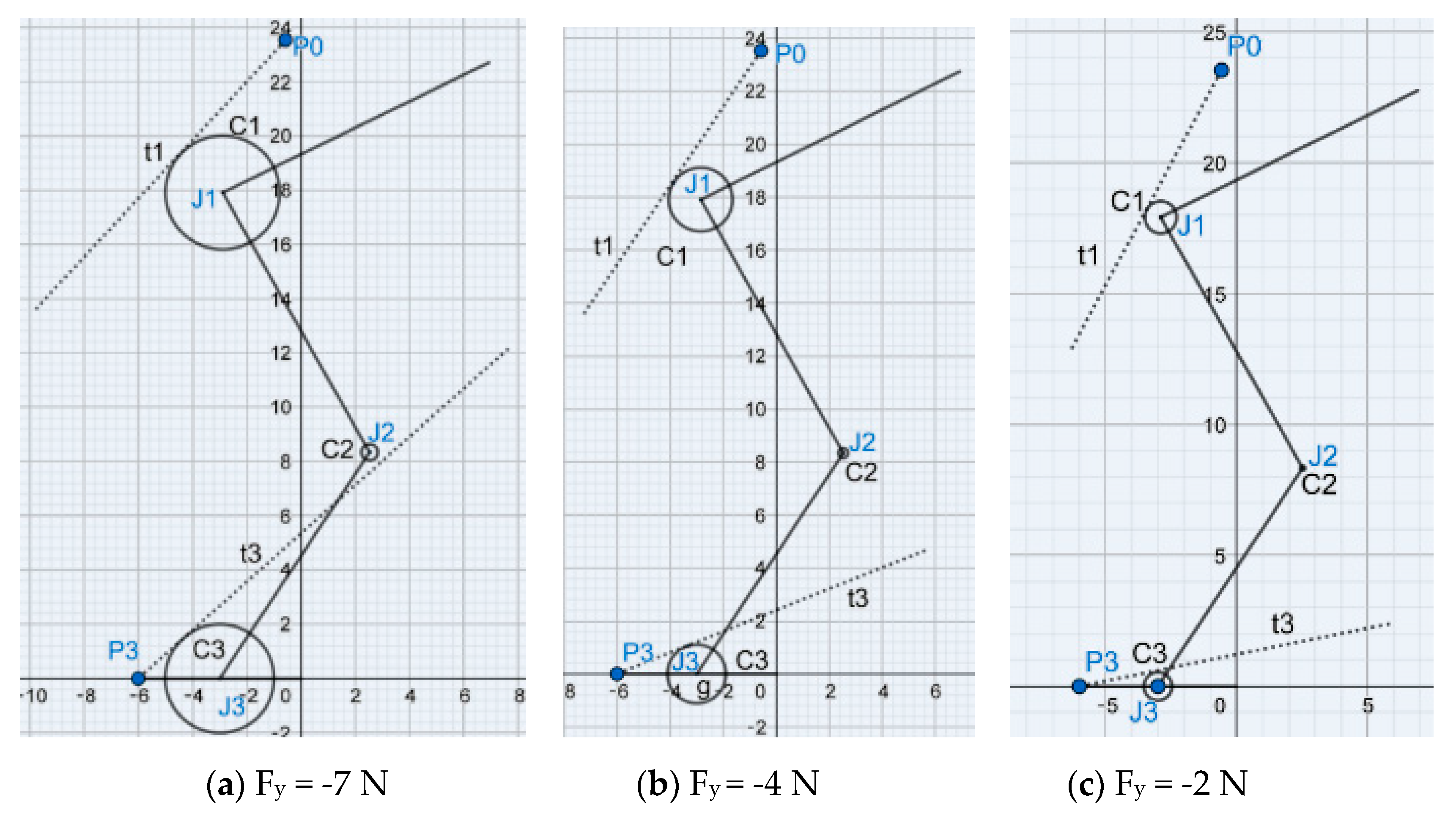
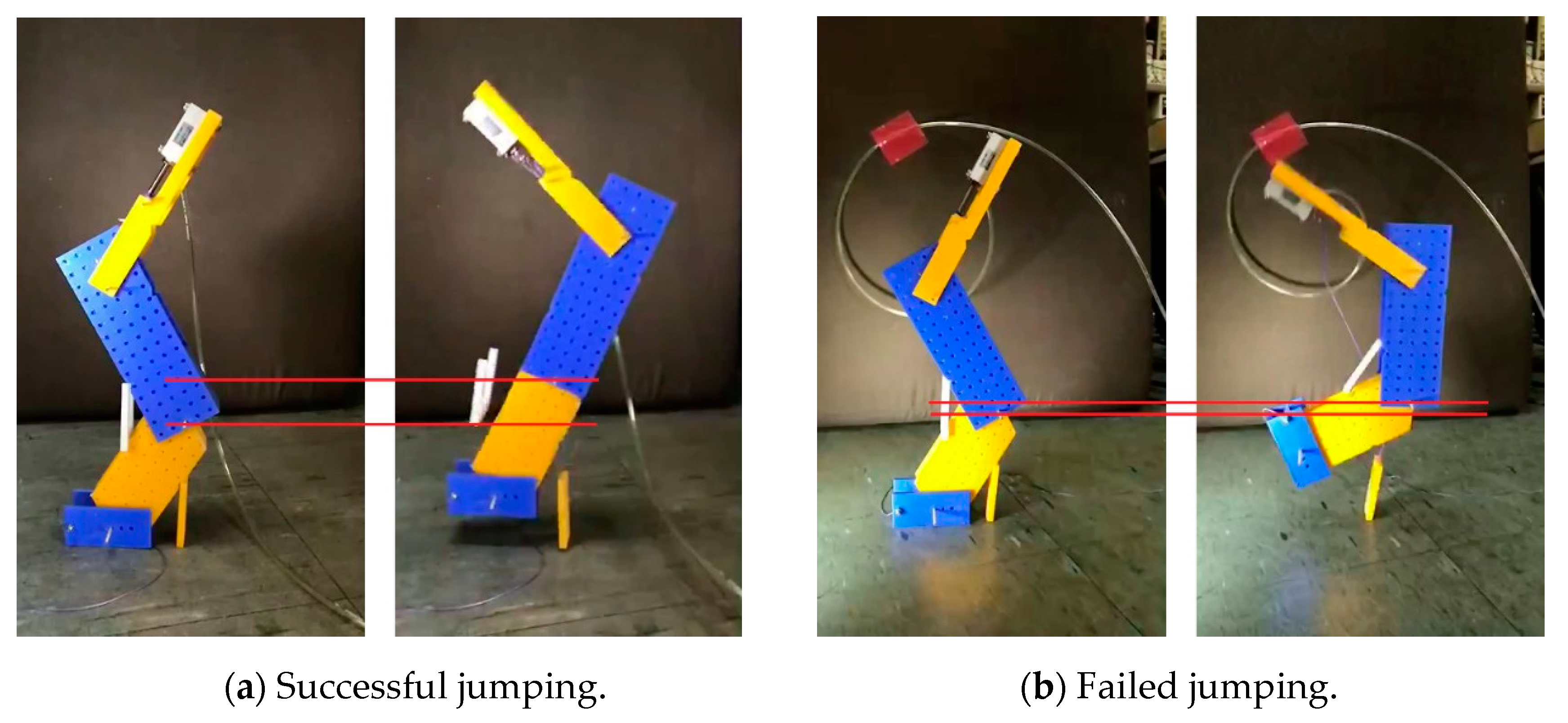
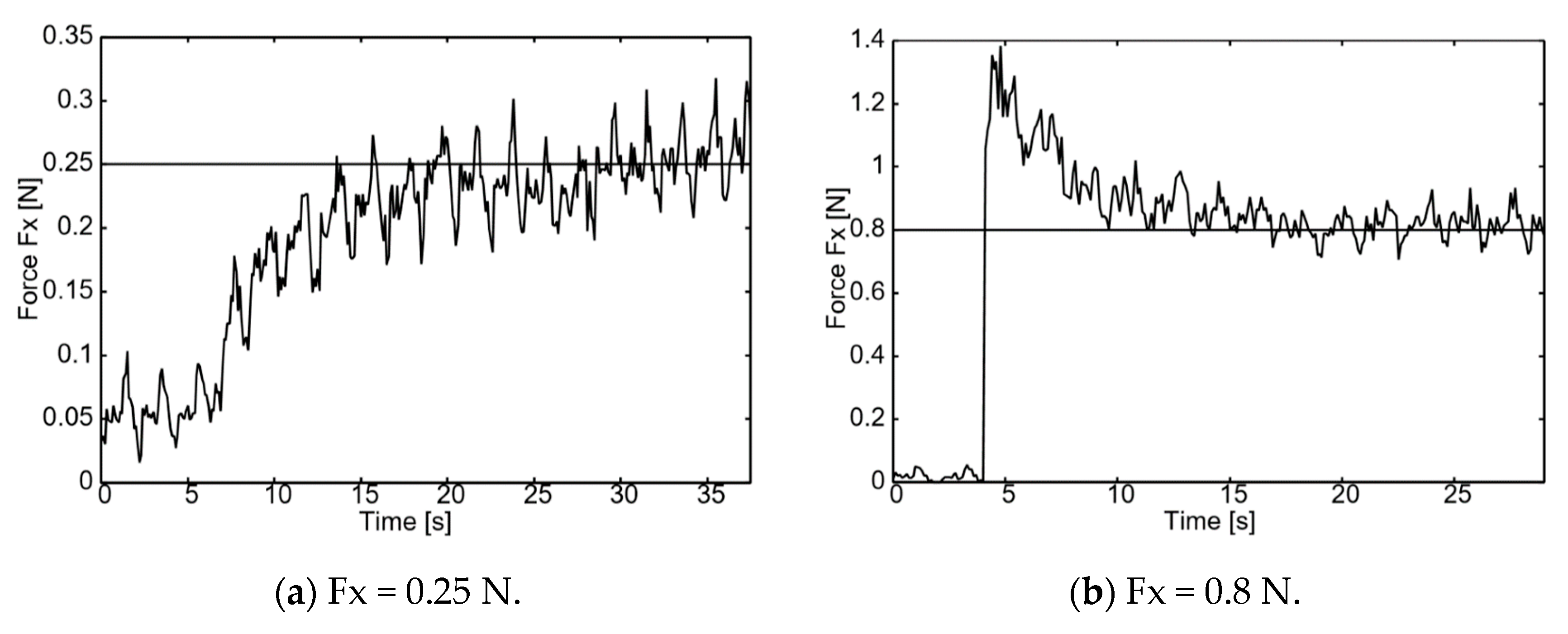
| Fy | C1 | C2 | C3 |
|---|---|---|---|
| −9.0 | 27.6 | 3.9 | 24.6 |
| −8.0 | 24.5 | 3.5 | 21.8 |
| −7.0 | 21.4 | 3.0 | 19.1 |
| −6.0 | 18.4 | 2.6 | 16.4 |
| −5.0 | 15.3 | 2.2 | 13.6 |
| −4.0 | 12.2 | 1.7 | 10.9 |
| −3.0 | 9.2 | 1.3 | 8.2 |
| −2.0 | 6.1 | 0.9 | 5.5 |
| −1.0 | 3.1 | 0.4 | 2.7 |
| Desired Fy [N] | xk [m] | yk [m] | xh [m] | yh [m] | Measured Fy [N] (rel. Error [%]) |
|---|---|---|---|---|---|
| −6.5 | −0.03 | 0.09 | −0.01 | 0.24 | −6.1 (6.2) |
| −6.8 | −0.01 | 0.09 | −0.03 | 0.23 | −6.5 (4.4) |
| −8.4 | −0.03 | 0.10 | −0.04 | 0.23 | −8.4 (0.0) |
| Number | Desired Fx [N] | [rad] | xk [m] | xh [m] | Measured Fx [N] (rel. Error [%]) |
|---|---|---|---|---|---|
| Fy [N] | yk [m] | yh [m] | Fy [N] (rel. Error [%]) | ||
| 1 | 0.25 | 1.53 | −0.02 | −0.04 | 0.26 (4.0) |
| −5.8 | 0.09 | 0.23 | −5.9 (1.7) | ||
| 2 | 0.3 | 1.52 | −0.01 | −0.01 | 0.31 (3.3) |
| −5.5 | 0.08 | 0.24 | −5.7 (3.6) | ||
| 3 | 0.4 | 1.51 | −0.02 | −0.05 | 0.44 (10.0) |
| −7.1 | 0.09 | 0.24 | −7.1 (0.0) | ||
| 4 | 0.5 | 1.50 | −0.01 | −0.05 | 0.51 (2.0) |
| −7.0 | 0.08 | 0.24 | −5.9 (15.7) | ||
| 5 | 0.8 | 1.39 | −0.01 | −0.04 | 0.83 (3.8) |
| −4.4 | 0.08 | 0.24 | −4.3 (2.3) |
© 2020 by the author. Licensee MDPI, Basel, Switzerland. This article is an open access article distributed under the terms and conditions of the Creative Commons Attribution (CC BY) license (http://creativecommons.org/licenses/by/4.0/).
Share and Cite
Takuma, T. Design of Tendon-Driven Mechanism Using Geometrical Condition. Actuators 2020, 9, 48. https://doi.org/10.3390/act9030048
Takuma T. Design of Tendon-Driven Mechanism Using Geometrical Condition. Actuators. 2020; 9(3):48. https://doi.org/10.3390/act9030048
Chicago/Turabian StyleTakuma, Takashi. 2020. "Design of Tendon-Driven Mechanism Using Geometrical Condition" Actuators 9, no. 3: 48. https://doi.org/10.3390/act9030048
APA StyleTakuma, T. (2020). Design of Tendon-Driven Mechanism Using Geometrical Condition. Actuators, 9(3), 48. https://doi.org/10.3390/act9030048





